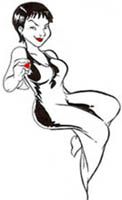Tuesday, October 25, 2005
Precedence of Description
Let’s talk grammar today, shall we? Don’t worry, my writerly comrades, this is probably something you already do instinctively; I’m just going to clarify why we do it, and how it works.The principle is called precedence of description. (You probably already gathered that from the title of this entry, yeah?) What it means is that there is an order we are supposed to apply when using descriptive words such as adjectives or adverbs. In other words, there’s a reason that the seven dwarfs* are referred to as “seven little men” and not “little seven men”—the rule is, the more definitive and/or permanent the descriptive word, the closer it should be placed to the word it describes.
“Er, what?” you ask, confused. Lemme ‘splain...
In our example of the seven dwarfs, there are several attributes we could use to describe them: there are seven of them, they are all comparatively little, they are evidently kind-hearted, and (in the Disney film version, at any rate) they are both funny and brave.
In order, probably the most definitive thing (that which most sets them apart) about our dwarfs is that they are dwarfs; i.e., little. This is what we call a description of inherent state—it is intrinsic to the creature or object described and not likely to change. So we would put the word “little” closest to the noun “men”, probably immediately before it.
The least definitive thing about them is their number—taken as a group, there are seven of them, but in theory, they are not always a complete roster of seven. (Someone has to go to the bathroom sometime, right?) Therefore, the descriptive word “seven”—being a description of number and thus highly subject to change—is placed furthest from the noun “men”, most likely at the very beginning of the descriptive phrase.
The rest of our descriptive words are descriptions of quality and are thus, to a certain extent, interchangeable in terms of order. Since we are clever writer/editors, though (We are, aren’t we?), we can see that there is a certain hierarchy of permanence discernable in our descriptions. Our dwarfs may be said to be kind most of the time and funny some of the time, but they don’t really show their bravery until the climax of the story. So out of our three qualitative descriptors, we would place the word “kind” closest to the noun, with the word “funny” preceding it, and the word “brave” before that.
The ideal descriptive phrase we end up with, then, is “seven brave, funny, kind little men”. Which is highly superior to the possible disordered version, “little, brave, kind, seven, funny men”, which you can see is confusing as hell.
A good rule of thumb when managing precedence of description is number, then quality, then inherent state (all in order of permanence, if applicable). Note that color can be either an adjective of quality (in general use) or inherent state (particularly in reference to racial heritage). In both cases, color is typically placed closest to the word described. E.g., “She is a fast white woman.”; “It is a fast white car.”
*Did you know?Check out the rest of the posse!
The originally prescribed plural form of the word “dwarf” is “dwarfs”, not “dwarves”. “Dwarves” was a term coined by linguistic scholar J.R.R. Tolkien to differentiate his fantastical race of creatures from human beings afflicted with what was then termed “dwarfism”. The word has since passed into general use and the two are now considered virtually interchangeable... though of course I’m a stickler for form, as always.

Cathy
Gabby
Sascha
Tobie










